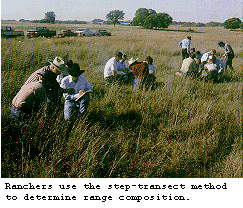
How Do I Determine The Species Composition Of My Rangeland?
Species composition can be quickly and easily determined using the step transect method. With this sampling technique one walks in a predetermined direction, from a permanently marked location, within a range site. As he walks, he records for every other step, the species of plant closest or under the toe of his boot. A minimum of 100 plants is needed, although 500 plants would be optimum to ensure accuracy. Once the desired number of plants are recorded, the percent composition for each species is calculated (i.e., 5 burrograss plants per 100 plants recorded = 5%). These percentages are then compared to the SCS technical guide for that site, and range condition determined.
Sampling should be restricted to specific range sites and not allowed to cross range site borders. When time becomes limiting, sampling should be prioritized toward those range sites receiving the most grazing pressure. Time requirements using this method are 30 minutes to two hours per site, depending on the number of plants recorded.
Since range condition changes relatively slowly, this method has no specific season when it must be conducted. However, fall is usually preferable because plants (especially grasses) are more easily identified at that time. All step transect lines should be reevaluated every two to three years.
What Is Range Trend?
Upward, downward or stable are terms describing range trend. Trend in condition is determined by comparing range condition at two points in time, preferably at least 3 to 5 years apart. Caution should be used when interpreting range trend. Very good or very poor precipitation years can affect species composition. Accurate precipitation records to supplement trend information will aid in its interpretation.
How Do I Monitor Range Trend?
Step Transects
 The
same data collected by step transects to determine range condition,
also indicate range trend. When range condition is known for 2 or more
points in time (usually 3 to 5 years apart), direction of change can be
determined.
The
same data collected by step transects to determine range condition,
also indicate range trend. When range condition is known for 2 or more
points in time (usually 3 to 5 years apart), direction of change can be
determined.
Authors: Allan McGinty, Larry D. White
